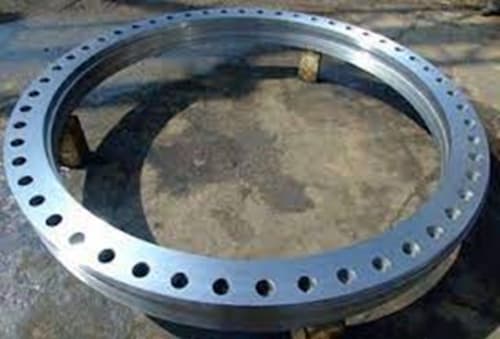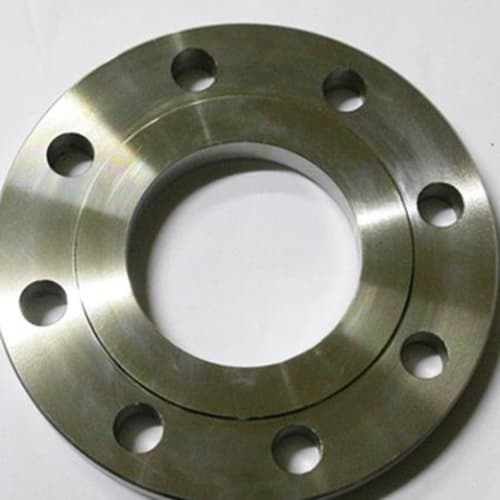A flange is a protruded ridge, lip, or rim, either external or internal, that serves to increase strength; for easy attachment/transfer of contact force with another object; or for stabilizing and guiding the movements of a machine or its parts. For example, sectional beams often have at least one flange that carries most of the load and that are connected by a web joining the flanges together. Pipes may also be fitted with flanges, which provide attachments. Nuts and bolts may include them to spread the clamping force over an increased area. The term “flange” is also used as a kind of tool used to form them.
Common Flange Types and Characteristics
Pipe flanges are classified according to how they are attached to the pipe. Types of pipe flange include:
Weld neck flanges are butt welded onto the end of a pipe, providing a flange that is suitable for high temperature and pressure.
Threaded flanges have an internal (female) thread, a threaded pipe is screwed into it. This is relatively easy to fit but not suitable for high pressure and temperature.
Socket-welded flanges have a plain hole with a shoulder at the bottom. The pipe is inserted into the hole to butt against the shoulder and is then welded into place with a fillet weld around the outside. This is used for small diameter pipes operating at low pressure.
Slip-on flanges also have a plain hole but without the shoulder. Fillet welds are applied to the pipe on both sides of the flange.
Lapped flanges consist of two parts; a stub end and a backing flange. The stub end is butt-welded to the end of the pipe and includes a small flange without any holes. The backing flange can slide over the stub end and provides holes to bolt to another flange. This arrangement allows disassembly in confined spaces.
Blind flanges are a form of blanking plate that is bolted to another pipe flange to isolate a section of piping or terminate piping.
Flange Standards
A flange standard lays down the dimensions, surface finish, facing type, marking, material and technical specifications. There are Flange Standardizations made by various institutions. For example institutions like ASME, AWWA, JIS, ISO, CEN have their Flange Standards. But in this Blog, we are gonna detailing AWWA and JIS Standards for Flanges.
What is AWWA ?
The American Water Works Association is an international, nonprofit, scientific, and educational society dedicated to providing total water solutions assuring the effective management of water. Founded in 1881, the Association is the largest organization of water supply professionals in the world.
AWWA’s membership includes over 4,300 utilities that supply roughly 80 percent of the US’s drinking water and treat almost half of the nation’s wastewater. Their 51,000 total members represent the full spectrum of the water community: public water and wastewater systems, environmental advocates, scientists, academicians, and others who hold a genuine interest in water.
AWWA Flanges
American Waterworks Association flanges are typically designed for low-pressure applications (300 psi or less). They are the opposite of API flanges and can be found in a wide variety of assemblies where the temperature is ambient and the medium is not corrosive. In most cases, it can be used not only for the transport of wells and sewers but also for fertilizer pipes and pipes with minimal pressure requirements.
AWWA flange standards differ in several respects from ANSI (American National Standards Institute) and ASME (American Society of Mechanical Engineers) certificates, especially in their specificity: AWWA standards do not assess more broadly, but specifically properties that affect drinking water use.
AWWA Certified Flange Types
Also unlike ANSI and ASME standards, AWWA Flange Standards do not address welded auxiliary connections or tapping. They cover a very specific range of flange types, including:
- Slip-on Ring and Hub Type Flanges, fitted over a pipe
- Blind Flanges, to seal or close a pipe or vessel
- Threaded Iron Flanges, fitted to externally threaded pipes
Some AWWA Flange Standards
AWWA C207: AWWA C207 steel flanges are usually composed of unalloyed carbon steel or a stainless steel version and are usually designed as a snap ring or structure of deaf discs. By design, they have no ring joints or raised surfaces and are usually sealed with rubber gaskets. Due to their cost and weight compared to other flange types, they are becoming increasingly popular in design work for structural steel types that require bonding or filling a gap between existing flanges. More Specifically, the American Water Works Association has published specification C207 to provide a standard for carbon steel rings and blinds. AWWA is a bit tolerant about which steel can also be used. C207 limits the carbon, phosphorus and sulfur content to 0.35%, 0.04%and 0.05%, respectively. Low requirements for minimum yield and tensile strength 32ksi and 50ksi respectively and enable many commercially rich brands of carbon steel, such as A516-70, A36, A105, A181-60.

AWWA C228-19: The purpose of this standard is to provide the minimum requirements for quicklime and hydrated lime, including physical, chemical, sampling, packaging, shipping, and testing requirements.
This standard can be referenced in documents for purchasing and receiving quicklime and hydrated lime and can be used as a guide for testing the physical and chemical properties of quicklime and hydrated lime samples. The stipulations of this standard apply when this document has been referenced and then only to quicklime and hydrated lime used in the treatment of potable water, wastewater, or reclaimed water.
Industries and Applications
The waterworks-specific AWWA Standard Flanges have been developed to meet light-duty applications, typically requiring performance at or below 300 psi. The most common pressure range is AWWA Class D, rated at 175 psi for sizes under 12 inches and 150 psi for larger sizes.
Common applications of AWWA Flanges include:
- Waterworks
- Slurry
- Waste water
- Plant piping
As a low-pressure piping solution, AWWA Standard Flanges can be an effective cost saver over ANSI or ASME forged flanges. These flanges, designed for oil, steam, or chemical applications and their demand for high pressure, are typically more expensive and less necessary for low-pressure piping.
What is JIS ?
Japanese Industrial Standards (JIS) are the standards used for industrial activities in Japan, coordinated by the Japanese Industrial Standards Committee (JISC) and published by the Japanese Standards Association (JSA). The JISC is composed of many nationwide committees and plays a vital role in standardizing activities across Japan.
JIS Flanges
For metric sizes, Japan Industrial Standard is yet another option. Provided in JIS5K, JIS10K, JIS15K, and JISK20K pressure classes, Yena Engineering can offer Slip-On, Blind, and Weld Neck, Socket Weld, and varieties.
Much like DIN / metric flanges, the JIS flange specification offers a slightly wider variety of slip weld configurations for space limitations and suitability for existing pipeline equipment. For instance, a customer can request a slip-on with or without a hub as standard, or even a ring-type flange, and all of this is within the same B2220 specification.
JIS flanges are widely used in pressure equipment and pipe assemblies exported from Japan. Many large and offshore vessels sailing in international waters and serving the Pacific use equipment conforming to this standard because parts and services of this specification are common.
Some JIS Flange Standards
JIS B2220: The most commonly used JIS B2220 5k Flange Face Type is raised face. Besides the raised type, the other JIS B2220 Flanges include types like flat face, Groove and Tongue Flange, and ring type joint. JIS B2220 Flange Material used by manufacturers to produce these flanges includes metals like stainless steel, carbon steel, alloy steel & nickel alloys.

Industries and Applications
Key markets and industries for JIS flanges are;
- Nuclear power (mostly seamless).
- Heavy oil refineries.
- Bitumen upgraders.
- Petrochemicals and acids.
JIS Flanges Application has lots of applications such as to Connect Pipe & Tubes in Power, Petroleum, Construction, Chemical, Gas, Shipbuilding, Metallurgy, etc.
You may check also this article: Forged Flanges – Production Method and Properties
References:
https://www.awwa.org
https://www.unifiedalloys.com/blog/flanges-101/
http://www.coastalflange.com/awwa.html
https://www.texasflange.com/flange-specs/awwa/
http://www.pipingpipeline.com/awwa-c207-steel-pipe-flg.html


